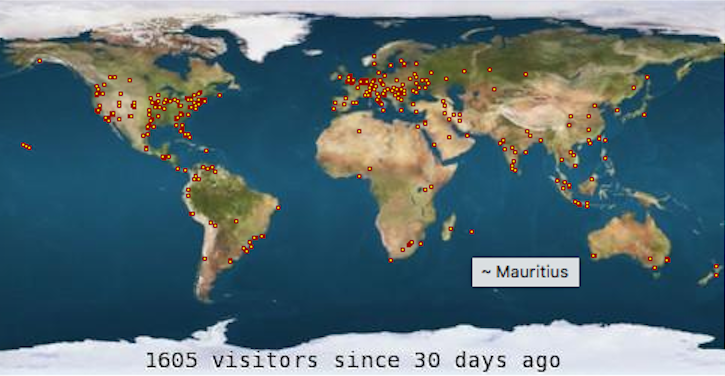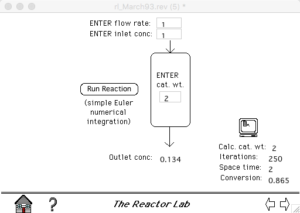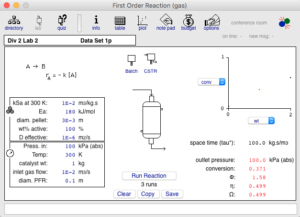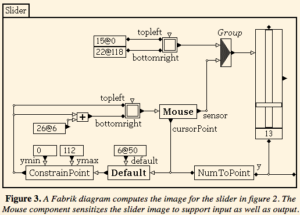We recently released the desktop Reactor Lab software as an open-source project on GitHub. View our open-source projects at https://github.com/RichardHerz. Contact us if you are interested in using this version or learning more about the structure and the code. The Lab is constructed with LiveCode, which can be obtained at https://livecode.com.
New Web Lab posted, dynamic catalytic reaction-diffusion
We posted a new web lab with a simulation of dynamic diffusion and reaction in a porous, solid catalyst layer.
This our first web lab with multiple plots: two strip charts showing time history, and two profile charts showing time-varying concentration profiles in the catalyst layer. The way we handle data for these plots is different than we do in Lab 1, which has one strip chart plot. Our code structure continues to be under development.
Web Labs are a new name for our Web app experiments. We moved the link to the Web Labs out of Resources to the top menu bar. One reason is the we are getting more interested in HTML5 for interactive simulations. We initially developed the new lab with LiveCode but found its speed too slow to handle solution of the partial differential equations. Javascript was much faster for this application.
Web app code structure
The first two web labs listed at the Web Labs tab have the latest Javascript code structure. Our approach is to have a collection of Javascript code objects, each of which represent individual process units, or “unit operations” in chemical engineering terminology. Each process unit object contains definitions of variables that define the current unit state, and methods that update the unit state at each time step. One objective is to make the unit code objects as independent as possible so that they can be copied and used in other simulations.
In an earlier post, we mentioned the web apps being developed by Tony Butterfield. His web apps have a different structure than ours, and it is interesting to compare these two approaches. You can view the source code of the web apps by choosing View Source in your web browser.
Butterfield’s web apps have a parent code object that defines a child object for each variable in the simulation. This is in contrast to our collection of process unit objects. You might say his app structure is variable-centered, whereas ours is process-unit centered. His variable object definition appears to have been entered in a spreadsheet and then translated to Javascript, since it is minified.
Butterfield’s web apps have a single method that updates the state of the simulation at each time step, vs. our process unit objects, each of which contain a method to update themselves at each time step. For plotting, his web apps record variables values at each time step in each variable object, vs. our 3D numeric array that records the history of all variable values, with individual process objects storing only their current values.
Both approaches work, and it is valuable to have a choice for web app development.
Margaret Hamilton and another approach to software development
I was interested to learn about the work of Margaret Hamilton, who was awarded the Presidential Medal of Freedom yesterday. As a young woman, she led a team that designed the flight control software for the Apollo moon landers. This period was during the early days of computer programming when software design practices were just starting to be invented. Hamilton developed a theory and methodology for “design before the fact” of fault-free and fault-tolerant, real-time software control systems. The class of systems considered are asynchronous, discrete-event systems. This includes chemical batch process scheduling and control. Our web apps simulate continuous processes. Design Before the Fact contrasts with the development strategy we use, as outlined in my last post, but we will learn from Hamilton’s work.
Also at the ceremony at the White House yesterday, Grace Hopper was posthumously awarded the Presidential Medal of Freedom. She was an early pioneer in computing, invented the first software compiler, and popularized the idea of machine-independent programming languages.
Also see the blog post about other women engineers who were key figures in the moon landings.
Web Labs – our development practice
The goal of our Web Labs is a toolbox that enables development of interactive web simulations or “labs,” and a set of labs built with this toolbox. Our development practice is as follows.
First, Get something up on the screen. Often this involves finding an example on the web and modifying it. Don’t spend a lot of time designing and thinking before something simple gets running. We believe that it is better to get something useful running than it is to have a beautiful plan and theory in development but nothing working to show for your time.
Second, repeat the following:
- Add functionality.
- As we observe repetition of code and see patterns developing, generalize the code. Have the objective of maximizing code in libraries and minimizing code needed to build new labs.
- As we observe patterns developing in the user interfaces, refine the design of a user interface guideline that is simple and consistent between labs in order to speed development of new labs and speed user comprehension when entering new labs.
- As we have time or run into problems 😛 read and learn about Javascript and CSS and design principles and try to incorporate better practices.
The most recent versions of the Javascript code are the first two labs listed at the Web Labs tab. The other experiments work but have code that was developed at an earlier stage of this software development process.
23 years of Reactor Lab and interactive simulations for active learning
Reactor Lab is a pioneer in developing interactive simulations for active learning. This is a screenshot of an experiment in the Lab in March 1993, when the Lab was a single HyperCard stack. The screenshot was taken after it was converted to a LiveCode stack to keep it alive and operable on today’s computers. Click on the image to see a larger version.
Here is the same experiment in today’s Reactor Lab.
A brief history of the development of Reactor Lab through 2006 is available at LiveCode Journal. The article refers to Revolution, which was LiveCode’s previous name.
Fabrik – early visual flow based programming tool
In an earlier post, I wrote about flow based programming (FBP). Recently, I ran across Fabrik, which was one of the first visual tools for FBP. One inspiration for Fabrik was Show and Tell.
In chemical engineering we wire, or rather pipe, visual components together in application-specific software tools to design chemical processes (see Resources, COCO Simulator here) and process control systems (Matlab Simulink).
“Fabrik – A Visual Programming Environment”
Dan Ingalls, Scott Wallace, Yu-Ying Chow, Frank Ludolph, Ken Doyle of Apple Computer.
presented at ACM, OOPSLA 1988 Conference Proceedings
http://web.archive.org/web/20080511202219/http://users.ipa.net/~dwighth/smalltalk/Fabrik/Fabrik.html
“Fabrik is a visual programming environment – a kit of computational and user-interface components that can be “wired” together to build new components and useful applications. … A kit is a set of primitive components, together with a framework for connecting the components to do new and interesting things…. The kit approach has been around for a long time, manifest in the subroutine libraries of the last three decades. However, the ability to browse through, and experiment with the available components was extremely primitive, owing to the textual orientation of underlying computing environments during those early years. … With the advent of iconic user interfaces, nontechnical users — those not trained to appreciate invisible objects and connections — are able to work concretely (by pointing at an image) with data and functional components.”
Women in engineering, a pioneer
“The unbelievable life of the forgotten genius [Katherine Johnson] who turned Americans’ space dreams into reality” http://www.businessinsider.com/katherine-johnson-hidden-figures-nasa-human-computers-2016-8
“Throughout her education, she says she succeeded in part because she was always asking questions — even when people tried to ignore her, her hand stayed up.”
Trailer for upcoming movie about Katherine Johnson, Hidden Figures: http://www.foxmovies.com/movies/hidden-figures
My advice to students for succeeding at the university
1) Study with at least one other student in each class. Get study buddies.
Don’t do it all alone. You will learn from other students, even when you show them how you figured things out. They will keep you honest when studying for a test: no peeking at notes when they ask a potential test question.
2) Schedule plenty of time to study and do homework. Do not overcommit.
Do not get too involved with work, student organizations, athletics, gaming, or partying. There are lots of interesting things to do at the university other than study.
Note: Not following (1) and (2) are almost always the reasons I have seen students struggle at UCSD. Everyone who gets admitted is smart enough. Don’t worry about that.
3) Talk to your professors and TAs.
A couple times during the term, ask them about topics in class or their research.
Do not always ask them about points on homework and tests. That will leave a negative impression of you. It is fine to ask about points, just not as the first question nor the only question.
At their office door, always remind them of your name, and ask them if they have a minute to talk about (fill in something interesting, not points). Do not ask, “are you busy?” Stupid question. Prof’s are always busy! Best not to approach them right before class.
Don’t wait until you are struggling in a class. Always talk to them if you do start to struggle for any reason, even if you haven’t talked to them before. Get help early!
If they know you, then you are more likely to get “the benefit of the doubt” during grading, e.g., drawing the grade line just below you instead of just above you.
4) Aim for A grades. Try to get at least B grades.
To keep open the option of going to grad school or professional school, you need to graduate with at least a 3.0 GPA overall. Also, you need at least 3.0 (B) average in your major if you want to continue in that major in grad school.
Most schools won’t admit a student to grad school with less than a 3.0 GPA, except in unusual, extenuating circumstances and with a sponsoring professor. Don’t rely on that. With less than a 3.0, your options are schools with lower standards, lower reputations, and higher costs.
5) The day before your first day of class, walk around campus and locate your classrooms.
Before serving on an advising panel one day, I asked a barista at Muir Woods the most important thing to tell new students. This is her advice. Sounds good to me.
Fun to see Visitor Maps
We recently added the Visitor Maps plugin to our About page. We are getting about 50 visitors per day. By clicking the “View more maps in the Visitor Map Viewer” link under the map, you can get versions where you can mouse over the map pins, wait, and get a tool tip showing where the pin is located. Here is a static screen shot:



